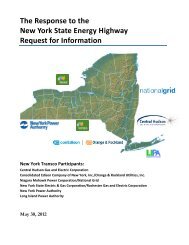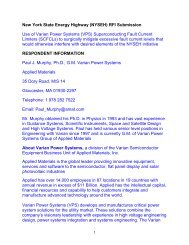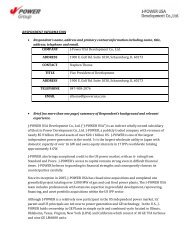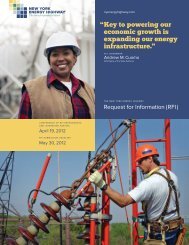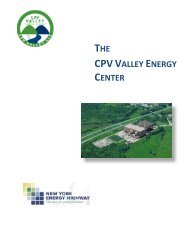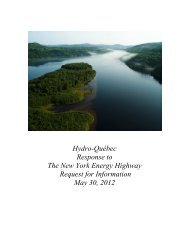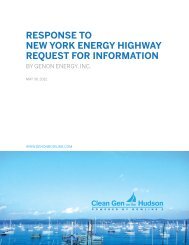Silicon Solution Joint Venture, LLC - Energy Highway
Silicon Solution Joint Venture, LLC - Energy Highway
Silicon Solution Joint Venture, LLC - Energy Highway
You also want an ePaper? Increase the reach of your titles
YUMPU automatically turns print PDFs into web optimized ePapers that Google loves.
US SOLAR – WHITE PAPER 24 May 2012<br />
This type of structure is an appealing one for solar project financing, but the second criterion<br />
presents the main obstacle. Rules for REIT eligibility do not allow (or at least do not explicitly<br />
allow) revenues associated with solar PPAs or leases to qualify as 'rental income', though the<br />
rules do provide for other exceptions under the 'rental income' definition (eg, services provided by<br />
hotels are considered REIT-eligible revenue).<br />
The momentum behind a 'solar REIT' concept is strong. The fit between real estate development<br />
and ownership and solar is a natural one, both because the physical assets are inevitably<br />
intertwined, and because the economics of both asset types have similar profiles (upfront costs,<br />
long-term payment streams). Bloomberg New <strong>Energy</strong> Finance has spoken to several parties<br />
which are exploring this concept as a business venture and others who are testing its viability in<br />
political circles – and even investigating whether it would be possible to gain S-REIT eligibility<br />
without legislative action. 7<br />
'YieldCos'<br />
Tax advantages aside, MLPs and REITs both offer an attraction that is at present non-existent in<br />
the US solar sector: the opportunity for any investor to access and own shares of productive<br />
dividend-yielding assets without illiquidity risk, and without exposure to other unrelated market<br />
segments at the same time.<br />
Developers could ‘spin<br />
out’ ownership of their<br />
generation assets to the<br />
public markets<br />
If, say, a retail investor seeks exposure to US solar development, the options are limited and<br />
'impure.' A typical retail investor would not have access to the types of private equity and private<br />
debt plays that typically fund projects today. 8 As an alternative, the investor could buy shares of<br />
publicly quoted companies such as First Solar or NRG, which develop solar projects. Yet, neither<br />
of these prominent examples are pure plays. First Solar is primarily a module manufacturer that<br />
develops projects. NRG is primarily a developer but owns many non-solar assets as well.<br />
The future of US solar project investment may include the emergence of pure-play operating<br />
companies. This could involve a developer ‘spinning out’ ownership of its generation assets to the<br />
public markets via an IPO to represent a ‘pure’ solar asset income fund. These entities have been<br />
referred to as ‘yieldcos’ by advocates of the scheme such as KeyBanc Capital Markets, with<br />
reference to the steady yields such companies could provide to investors. Yieldcos present an<br />
investment profile similar to REITs as they are non-cyclical, are based off of fixed assets, and can<br />
provide stable dividend yields. An interviewee championed the structure as being “better than<br />
REITs” because revenue is based off of long-term escalating PPAs with generally high-credit<br />
offtakers (whereas the real estate assets in REITs tend to have shorter term leases and<br />
potentially lower credit tenants).<br />
The concept is not new in the energy industry, and there are a handful of operating yieldcos in the<br />
market today, though most are internationally focused. The most relevant example may be<br />
Brookfield Asset Management's spin-out of a public market fund that owns renewable assets (see<br />
Case Study 5.2). A yieldco could undertake development itself (though this would dilute a fund<br />
focused purely on asset ownership), acquire projects from third-party developers, or acquire<br />
companies directly from the original ‘development arm’ of the company, effectively bifurcating<br />
development from ownership.<br />
There are two chief obstacles to the yieldco concept. The first is scale. Bankers familiar with these<br />
structures suggest a minimum IPO size for a new yieldco would need to be roughly $150–200m,<br />
7 A useful introduction to the solar REIT concept, and the source for much of the S-REIT characterisation<br />
above, is a two-page whitepaper, 'The Case for Solar REITs' by Kenneth Kramer of Rushton Atlantic <strong>LLC</strong>.<br />
8 An investor could of course acquire his own solar system – eg, for his own rooftop. But if the investment is<br />
simply a matter of quenching the investor's desire to gain exposure to the solar development sector, this<br />
approach has a 'killing an ant with a Sherman tank' quality: the upfront cost is several orders of magnitude<br />
higher than what a typical investor may allocate to a single stock, the investment leaves the investor<br />
vulnerable to single-project risk without diversification, and the asset would be far from liquid.<br />
© Bloomberg New <strong>Energy</strong> Finance 2012<br />
Strictly no copying, forwarding, shared passwords or redistribution allowed without prior written permission<br />
of Bloomberg New <strong>Energy</strong> Finance. For more information on terms of use, please contact<br />
sales.bnef@bloomberg.net. Copyright and Disclaimer notice on page 28 applies throughout. Page 19 of 28



